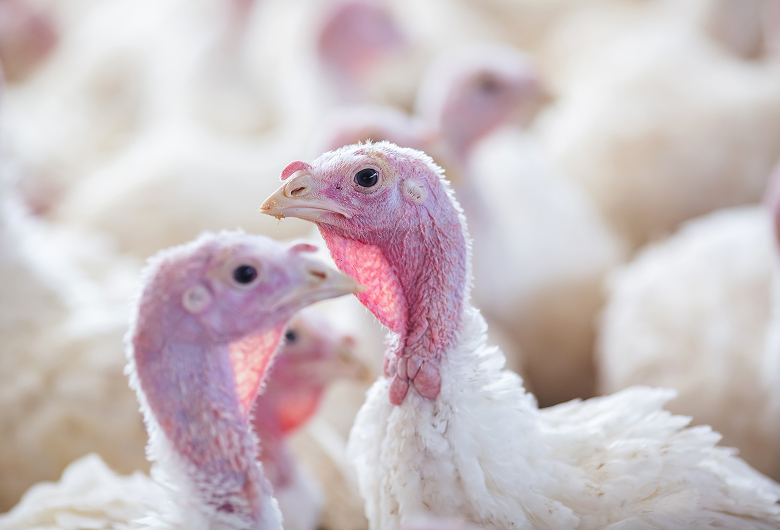

Optimize gut health in turkeys during viral challenges
by Dr. Ann Wooming, Poultry Technical Services ManagerChances are, if you work in the poultry industry, you’ve heard about avian metapneumovirus (aMPV). The first flocks were affected in the fall of 2023 and by early 2024 the virus was confirmed on both coasts of the United States. The virus has spread rapidly across the U.S. and has been detected in nearly every state which grows commercial turkey.1
An upper-respiratory disease, aMPV affects birds of any age but is more severe in younger birds. Clinical signs are not specific to aMPV so confirmation needs to be done by a diagnostic lab. The signs of an infection with aMPV include mucus or discharge from the nares, swollen sinuses, coughing and, in the case of breeder birds, a drop in egg production. How this latest incidence of aMPV emerged in the US is still being investigated but what is known is that the virus is highly contagious and highly transmissible through direct bird to bird contact with infected respiratory secretions.2
Infection with aMPV has been demonstrated to be immunosuppressive in turkeys. During the initial stages of aMPV infection the immune system becomes temporarily compromised. The infected cells lining the respiratory tract are then more susceptible to secondary infections from E. coli, Ornithobacterium rhinotracheale (ORT) and other bacterial opportunistic pathogens.2 These secondary infections lead to increased morbidity and mortality in the flock.
Focus on prevention
Recently a vaccine was made available to help prevent turkeys from being infected with aMPV. Even though the vaccine is available, detecting aMPV infection in its earliest stages and focusing on minimizing morbidity and mortality due to secondary infection is the current strategy. Treatment of secondary infections often includes the use of antibiotics in conventional flocks.
It goes without saying, that as with other highly transmissible and communicable diseases a focus on prevention is of the utmost importance. Biosecurity measures are important, just as they are with prevention of any transmissible disease. One potential strategy for mitigating the impact of a disease challenge is to produce a more robust and resilient bird.
Gut health optimization makes an impact
One area of the bird to focus on which has a direct impact on resiliency and the immune system is the GI tract. The GI tract has a multifactor mechanism to directly deal with agents that are bad for bird health. The mechanism consists of a trifecta of a physical barrier formed by the intestinal epithelial layer, the bird microbiome which may be hostile to the disease agent and finally the gut hosts up to between 70-80% cells necessary for immune response.3 Adding specific feed ingredients to the diet can have an impact on the response from the bird to a disease challenge by playing a positive role in each of the mechanisms mentioned above.
CERTILLUSTM utilizes proprietary strains of Bacillus probiotic bacteria proven to be beneficial in many aspects of bird health and productivity. It can be customized to address the specific pathogen challenges faced by your birds while delivering benefits to the overall gut health of the bird.
Our CERTILLUSTM strains can be directly added to the diets at the feed mill and survive the milling process. Putting CERTILLUS in the feed ensures an easy, consistent dosing for continued benefits. Our Bacillus strains are capable of acting on the gut microbiome to inhibit the growth of Avian Pathogen E.coli (APEC) a known cause of colibacillosis. In addition to reducing the pathogen burden in the gut, there are positive effects on the tightening of the gut epithelial cells which form a physical barrier to pathogens.
In addition to CERTILLUSTM, our gut health portfolio at Arm & Hammer Animal Nutrition includes CELMANAXTM, a yeast culture plus Refined Functional CarbohydratesTM (RFCTM). In addition to other benefits related to productivity, yeast culture plus RFC’s also provide supportive effects in the GI tract. They function as prebiotics to feed the good bacteria in the gut which is important for a healthy gut microbiome and for fighting dysbiosis. They are capable of binding to pathogens and interfering with their binding to the gut epithelial cells, which hinders a major mode of action utilized by pathogens. Finally, there are numerous studies which focus on and describe the immunological benefits of yeast culture and RFC’s on both innate and humoral immune responses.
Take steps now
If you are ready to help improve the ability of your flock to withstand disease challenges from day one onward, work with your nutritionist or veterinarian to add CELMANAX and CERTILLUS to your diets. Begin making your flock more resilient to help reduce the impact of secondary infections.
Contact your ARM & HAMMER representative today to discuss options.
1 Franzo, G.; Legnardi, M.; Faustini, G.; Baston, R.; Poletto, F.; Cecchinato, M.; Tucciarone, C.M. Tracing the Flight: Investigating the Introduction of Avian Metapneumovirus (aMPV) A and B. Animals 2024, 14, 1786. https://doi.org/10.3390/ani14121786
2 K. Kaboudi, J. Lachheb, Avian metapneumovirus infection in turkeys: a review on turkey rhinotracheitis, Journal of Applied Poultry Research, Volume 30, Issue 4, 2021, 100211, ISSN 1056-6171, https://doi.org/10.1016/j.japr.2021.100211.
3 Wiertsema, S. P., Garssen, J., & J. Knippels, L. M. (2021). The Interplay between the Gut Microbiome and the Immune System in the Context of Infectious Diseases throughout Life and the Role of Nutrition in Optimizing Treatment Strategies. Nutrients, 13(3).

